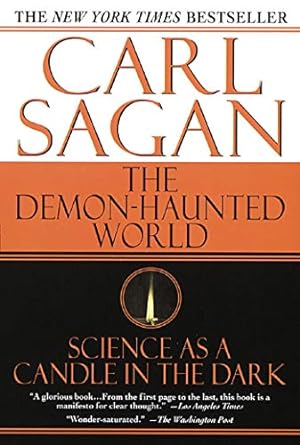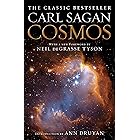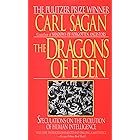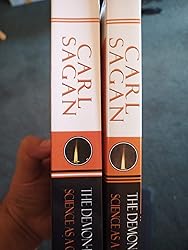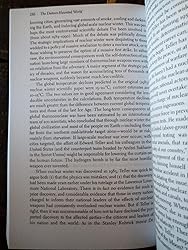| Print List Price: | $18.99 |
| Kindle Price: | $7.99 Save $11.00 (58%) |
| Sold by: | Random House LLC Price set by seller. |
Your Memberships & Subscriptions

Download the free Kindle app and start reading Kindle books instantly on your smartphone, tablet, or computer - no Kindle device required.
Read instantly on your browser with Kindle for Web.
Using your mobile phone camera - scan the code below and download the Kindle app.
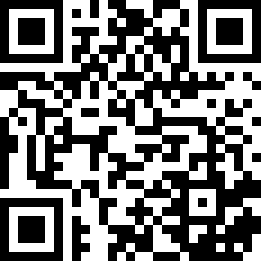


 Audible sample Sample
Audible sample Sample The Demon-Haunted World: Science as a Candle in the Dark Kindle Edition

Explore your book, then jump right back to where you left off with Page Flip.
View high quality images that let you zoom in to take a closer look.
Enjoy features only possible in digital – start reading right away, carry your library with you, adjust the font, create shareable notes and highlights, and more.
Discover additional details about the events, people, and places in your book, with Wikipedia integration.
LOS ANGELES TIMES BOOK PRIZE WINNER • “Glorious . . . A spirited defense of science . . . From the first page to the last, this book is a manifesto for clear thought.”—Los Angeles Times
How can we make intelligent decisions about our increasingly technology-driven lives if we don’t understand the difference between the myths of pseudoscience, New Age thinking, and fundamentalist zealotry and the testable hypotheses of science?
Casting a wide net through history and culture, Pulitzer Prize–winning author and distinguished astronomer Carl Sagan argues that scientific thinking is critical not only to the pursuit of truth but to the very well-being of our democratic institutions. He examines and authoritatively debunks such celebrated fallacies as witchcraft, faith healings, demons, and UFOs. And yet, disturbingly, in today’s so-called information age, pseudoscience is burgeoning, with stories of alien abduction, “channeling” past lives, and communal hallucinations commanding growing attention and respect.
As Sagan demonstrates with lucid eloquence, the siren song of unreason is not just a cultural wrong turn but a dangerous plunge into darkness that threatens our most basic freedoms.
- LanguageEnglish
- PublisherBallantine Books
- Publication dateJuly 6, 2011
- File size3836 KB
Customers who bought this item also bought
 It is morally as bad not to care whether a thing is true or not, so long as it makes you feel good, as it is not to care how you got your money as long as you have got it.Highlighted by 3,180 Kindle readers
It is morally as bad not to care whether a thing is true or not, so long as it makes you feel good, as it is not to care how you got your money as long as you have got it.Highlighted by 3,180 Kindle readers The method of science, as stodgy and grumpy as it may seem, is far more important than the findings of science.Highlighted by 2,401 Kindle readers
The method of science, as stodgy and grumpy as it may seem, is far more important than the findings of science.Highlighted by 2,401 Kindle readers Pseudoscience speaks to powerful emotional needs that science often leaves unfulfilled.Highlighted by 2,358 Kindle readers
Pseudoscience speaks to powerful emotional needs that science often leaves unfulfilled.Highlighted by 2,358 Kindle readers
Editorial Reviews
Amazon.com Review
From Publishers Weekly
Copyright 1995 Reed Business Information, Inc.
From Library Journal
-?Gregg Sapp, Univ. of Miami Lib., Coral Gables, Fla.
Copyright 1996 Reed Business Information, Inc.
From Booklist
Review
“Powerful . . . A stirring defense of informed rationality. . . Rich in surprising information and beautiful writing.”—The Washington Post Book World
“Compelling.”—USA Today
“A clear vision of what good science means and why it makes a difference. . . . A testimonial to the power of science and a warning of the dangers of unrestrained credulity.”—The Sciences
“Passionate.”—San Francisco Examiner-Chronicle
From the Back Cover
*Los Angeles Times
"POWERFUL . . . A stirring defense of informed rationality. . . Rich in surprising information and beautiful writing."
*The Washington Post Book World
How can we make intelligent decisions about our increasingly technology-driven lives if we don't understand the difference between the myths of pseudoscience and the testable hypotheses of science? Pulitzer Prize-winning author and distinguished astronomer Carl Sagan argues that scientific thinking is critical not only to the pursuit of truth but to the very well-being of our democratic institutions.
Casting a wide net through history and culture, Sagan examines and authoritatively debunks such celebrated fallacies of the past as witchcraft, faith healing, demons, and UFOs. And yet, di
About the Author
Excerpt. © Reprinted by permission. All rights reserved.
THE MOST PRECIOUS THING
All our science, measured against reality, is primitive and childlike—and yet it is the most precious thing we have.
ALBERT EINSTEIN
(1879–1955)
As I got off the plane, he was waiting for me, holding up a scrap of cardboard with my name scribbled on it. I was on my way to a conference of scientists and TV broadcasters devoted to the seemingly hopeless prospect of improving the presentation of science on commercial television. The organizers had kindly sent a driver.
“Do you mind if I ask you a question?” he said as we waited for my bag.
No, I didn’t mind.
“Isn’t it confusing to have the same name as that scientist guy?”
It took me a moment to understand. Was he pulling my leg? Finally, it dawned on me.
“I am that scientist guy,” I answered.
He paused and then smiled. “Sorry. That’s my problem. I thought it was yours too.”
He put out his hand. “My name is William F. Buckley.” (Well, he wasn’t exactly William F. Buckley, but he did bear the name of a contentious and well-known TV interviewer, for which he doubtless took a lot of good-natured ribbing.)
As we settled into the car for the long drive, the windshield wipers rhythmically thwacking, he told me he was glad I was “that scientist guy”—he had so many questions to ask about science. Would I mind?
No, I didn’t mind.
And so we got to talking. But not, as it turned out, about science. He wanted to talk about frozen extraterrestrials languishing in an Air Force base near San Antonio, “channeling” (a way to hear what’s on the minds of dead people—not much, it turns out), crystals, the prophecies of Nostradamus, astrology, the shroud of Turin … He introduced each portentous subject with buoyant enthusiasm. Each time I had to disappoint him:
“The evidence is crummy,” I kept saying. “There’s a much simpler explanation.”
He was, in a way, widely read. He knew the various speculative nuances on, let’s say, the “sunken continents” of Atlantis and Lemuria. He had at his fingertips what underwater expeditions were supposedly just setting out to find the tumbled columns and broken minarets of a once-great civilization whose remains were now visited only by deep sea luminescent fish and giant kraken. Except … while the ocean keeps many secrets, I knew that there isn’t a trace of oceanographic or geophysical support for Atlantis and Lemuria. As far as science can tell, they never existed. By now a little reluctantly, I told him so.
As we drove through the rain, I could see him getting glummer and glummer. I was dismissing not just some errant doctrine, but a precious facet of his inner life.
And yet there’s so much in real science that’s equally exciting, more mysterious, a greater intellectual challenge—as well as being a lot closer to the truth. Did he know abo ut the molecular building blocks of life sitting out there in the cold, tenuous gas between the stars? Had he heard of the footprints of our ancestors found in 4-million-year-old volcanic ash? What about the raising of the Himalayas when India went crashing into Asia? Or how viruses, built like hypodermic syringes, slip their DNA past the host organism’s defenses and subvert the reproductive machinery of cells; or the radio search for extraterrestrial intelligence; or the newly discovered ancient civilization of Ebla that advertised the virtues of Ebla beer? No, he hadn’t heard. Nor did he know, even vaguely, about quantum indeterminacy, and he recognized DNA only as three frequently linked capital letters.
Mr. “Buckley”—well-spoken, intelligent, curious—had heard virtually nothing of modern science. He had a natural appetite for the wonders of the Universe. He wanted to know about science. It’s just that all the science had gotten filtered out before it reached him. Our cultural motifs, our educational system, our communications media had failed this man. What the society permitted to trickle through was mainly pretense and confusion. It had never taught him how to distinguish real science from the cheap imitation. He knew nothing about how science works.
There are hundreds of books about Atlantis—the mythical continent that is said to have existed something like 10,000 years ago in the Atlantic Ocean. (Or somewhere. A recent book locates it in Antarctica.) The story goes back to Plato, who reported it as hearsay coming down to him from remote ages. Recent books authoritatively describe the high level of Atlantean technology, morals, and spirituality, and the great tragedy of an entire populated continent sinking beneath the waves. There is a “New Age” Atlantis, “the legendary civilization of advanced sciences,” chiefly devoted to the “science” of crystals. In a trilogy called Crystal Enlightenment, by Katrina Raphaell—the books mainly responsible for the crystal craze in America—Atlantean crystals read minds, transmit thoughts, are the repositories of ancient history and the model and source of the pyramids of Egypt. Nothing approximating evidence is offered to support these assertions. (A resurgence of crystal mania may follow the recent finding by the real science of seismology that the inner core of the Earth may be composed of a single, huge, nearly perfect crystal—of iron.)
A few books—Dorothy Vitaliano’s Legends of the Earth, for example—sympathetically interpret the original Atlantis legends in terms of a small island in the Mediterranean that was destroyed by a volcanic eruption, or an ancient city that slid into the Gulf of Corinth after an earthquake. This, for all we know, may be the source of the legend, but it is a far cry from the destruction of a continent on which had sprung forth a preternaturally advanced technical and mystical civilization.
What we almost never find—in public libraries or newsstand magazines or prime time television programs—is the evidence from sea floor spreading and plate tectonics, and from mapping the ocean floor which shows quite unmistakably that there could have been no continent between Europe and the Americas on anything like the timescale proposed.
Spurious accounts that snare the gullible are readily available. Skeptical treatments are much harder to find. Skepticism does not sell well. A bright and curious person who relies entirely on popular culture to be informed about something like Atlantis is hundreds or thousands of times more likely to come upon a fable treated uncritically than a sober and balanced assessment.
Maybe Mr. “Buckley” should know to be more skeptical about what’s dished out to him by popular culture. But apart from that, it’s hard to see how it’s his fault. He simply accepted what the most widely available and accessible sources of information claimed was true. For his naïveté, he was systematically misled and bamboozled.
Science arouses a soaring sense of wonder. But so does pseudoscience. Sparse and poor popularizations of science abandon ecological niches that pseudoscience promptly fills. If it were widely understood that claims to knowledge require adequate evidence before they can be accepted, there would be no room for pseudoscience. But a kind of Gresham’s Law prevails in popular culture by which bad science drives out good.
All over the world there are enormous numbers of smart, even gifted, people who harbor a passion for science. But that passion is unrequited. Surveys suggest that some 95 percent of Americans are “scientifically illiterate.” That’s just the same fraction as those African Americans, almost all of them slaves, who were illiterate just before the Civil War—when severe penalties were in force for anyone who taught a slave to read. Of course there’s a degree of arbitrariness about any determination of illiteracy, whether it applies to language or to science. But anything like 95 percent illiteracy is extremely serious.
Every generation worries that educational standards are decaying. One of the oldest short essays in human history, dating from Sumer some 4,000 years ago, laments that the young are disastrously more ignorant than the generation immediately preceding. Twenty-four hundred years ago, the aging and grumpy Plato, in Book VII of the Laws, gave his definition of scientific illiteracy:
Who is unable to count one, two, three, or to distinguish odd from even numbers, or is unable to count at all, or reckon night and day, and who is totally unacquainted with the revolution of the Sun and Moon, and the other stars … All freemen, I conceive, should learn as much of these branches of knowledge as every child in Egypt is taught when he learns the alphabet. In that country arithmetical games have been invented for the use of mere children, which they learn as pleasure and amusement … I … have late in life heard with amazement of our ignorance in these matters; to me we appear to be more like pigs than men, and I am quite ashamed, not only of myself, but of all Greeks.
I don’t know to what extent ignorance of science and mathematics contributed to the decline of ancient Athens, but I know that the consequences of scientific illiteracy are far more dangerous in our time than in any that has come before. It’s perilous and foolhardy for the average citizen to remain ignorant about global warming, say, or ozone depletion, air pollution, toxic and radioactive wastes, acid rain, topsoil erosion, tropical deforestation, exponential population growth. Jobs and wages depend on science and technology. If our nation can’t manufacture, at high quality and low price, products people want to buy, then industries will continue to drift away and transfer a little more prosperity to other parts of the world. Consider the social ramifications of fission and fusion power, supercomputers, data “highways,” abortion, radon, massive reductions in strategic weapons, addiction, government eavesdropping on the lives of its citizens, high-resolution TV, airline and airport safety, fetal tissue transplants, health costs, food additives, drugs to ameliorate mania or depression or schizophrenia, animal rights, superconductivity, morning-after pills, alleged hereditary antisocial predispositions, space stations, going to Mars, finding cures for AIDS and cancer.
Product details
- ASIN : B004W0I00Q
- Publisher : Ballantine Books; Reprint edition (July 6, 2011)
- Publication date : July 6, 2011
- Language : English
- File size : 3836 KB
- Text-to-Speech : Enabled
- Screen Reader : Supported
- Enhanced typesetting : Enabled
- X-Ray : Enabled
- Word Wise : Enabled
- Sticky notes : On Kindle Scribe
- Print length : 482 pages
- Page numbers source ISBN : 0345409469
- Best Sellers Rank: #26,769 in Kindle Store (See Top 100 in Kindle Store)
- #1 in Science Education Research
- #1 in Science Methodology & Statistics
- #5 in Scientific Research
- Customer Reviews:
About the author

Carl Sagan was Professor of Astronomy and Space Sciences and Director of the Laboratory for Planetary Studies at Cornell University. He played a leading role in the Mariner, Viking, and Voyager spacecraft expeditions to the planets, for which he received the NASA medals for Exceptional Scientific Achievement. Dr. Sagan received the Pulitzer Prize and the highest awards of both the National Academy of Sciences and the National Science Foundation, and many other awards, for his contributions to science, literature, education, and the preservation of the environment. His book Cosmos (accompanying his Emmy- and Peabody Award-winning television series of the same name) was the bestselling science book ever published in the English language, and his bestselling novel, Contact, was turned into a major motion picture.
Photo by NASA/JPL [Public domain], via Wikimedia Commons.
Customer reviews
Customer Reviews, including Product Star Ratings help customers to learn more about the product and decide whether it is the right product for them.
To calculate the overall star rating and percentage breakdown by star, we don’t use a simple average. Instead, our system considers things like how recent a review is and if the reviewer bought the item on Amazon. It also analyzed reviews to verify trustworthiness.
Learn more how customers reviews work on AmazonCustomers say
Customers find the book very worthy and interesting, with insightful analyses of the situation. They also say the content is tremendously kind to religious readers, but still stresses the downsides of credulity. Readers appreciate the clear, well-written prose and easy to follow. They mention the book is a true candle in the darkness, with wisdom and compassion.
AI-generated from the text of customer reviews
Customers find the book brilliant, fun, and interesting. They also say the author weaves a clear and convincing argument that combines science and critical thought. Readers also appreciate the interesting anecdotes and insightful analyses of the situation.
"...Overall, a very worthy read that I give a strong five stars." Read more
"...This is one of the last books he wrote. It is also one of the best...." Read more
"It cost me $5 for the E-book. It's worth every penny...." Read more
"1. "Science is fun and easy."..." Read more
Customers find the book insightful, rational, and entertaining. They say it tackles the spread of pseudoscience and superstition in modern society. Readers also appreciate the clear-minded skepticism and thoughtful analysis. They describe the book as a true candle in the darkness.
"...world of ungrounded thought, I feel comforted by Sagan's sagely, skeptical words. "Skepticism doesn't sell newspapers," he explains...." Read more
"...It is also one of the best. It tackles the spread of pseudoscience and superstition in modern society, with a special focus on the US in the late..." Read more
"...As momentous, relevant, and urgent though Sagan's message was, its infiltration remains woefully incomplete...." Read more
"...nonsense, and Sagan explains why, using engaging prose and a matter-of-fact approach...." Read more
Customers find the book well-written, easy to follow, and well presented. They say it challenges the reader to rely on evidence and lays out the importance of rational thought.
"...with his wildly popular PBS series "Cosmos." His manner of speaking was engaging. He was a recurring guest on Johnny Carson's show...." Read more
"Brilliantly written. Even a dummy like me can understand the entire book even though it was written by one of the most brilliant men of our time." Read more
"Sagan’s prose and narrative are spectacular and tempered arguments against the ongoing decay of education worldwide...." Read more
"Well written book. The topics discussed in this book are even more applicable and important in today's world of disinformation." Read more
Customers find the book poignant, compassionate, and wise. They also describe the characters as level-headed, objective, and non-emotional. Readers also say the book feels prophetic, with clever insight, perspective, humor, and depth.
"...- but I found this to be very pleasant, informative, and relatable in an odd way." Read more
"...I never finished it (lost the book), but did in its digital download. Poignant and profound, this is an introduction in critical thinking and..." Read more
"...This book covers all bases. It's very emotional but also very practical...." Read more
"...We need more books like this--readable, logical, sensible, humane, and loving--and more people like Carl Sagan and Ann Druyan...." Read more
Customers have mixed opinions about the writing style. Some find the pages soft, smooth, and comforting. Others find it long-winded and repetitive.
"...In every dissection he is gentle and compassionate. What a scientist. Carl Sagan is a brilliant man...." Read more
"Whilst I enjoyed the book I found it a little long winded with much repetition...." Read more
"...away from it carl's thoughts are refreshing, enlightening and comforting...." Read more
"I found it to be a little bit repetitive, but otherwise very thought-provoking and intelligent. I'm glad I read it." Read more
Reviews with images
Great book, horrible packing
-
Top reviews
Top reviews from the United States
There was a problem filtering reviews right now. Please try again later.
"Some portion of the decision-making that influences the future of our civilization is plainly in the hands of charlantans," Sagan writes. "When we are self indulgent and uncritical, when we confuse hopes and facts, we slide into pseudoscience and superstition."
Carl Sagan's question for a possible extraterrestrial was, "Please provide a short proof of Fermat's Last Theorem."
"How is it, I ask myself, that UFO occupants are so bound to fashionable or urgent concerns on this planet? Why not even an incidental warning about CFCs and oxone depletion in the 1950s, or about the AHIV virus in the 1979s, when it might have really done some good?"
Sagan thoroughly elucidates the most common strategies used to defend perilous fallacies of logic and rhetoric.
In this book, he includes some history of the founding father's of the U.S. who were "realistic and practical, wrote their own speeches, and were motivated by high principles." He also uses examples of leaders and events in Europe, Russia, and China, and how they thought in ways that were superior to the dreck we have spiraled down to. He admires Jefferson's response to the Sedition Act and Linus Pauling's stance against nuclear weapons and involvement in the Limited Test Ban Treaty of 1963. Sagan himself took an anti-nuclear stance.
Carl Sagan wisely implores us to question everything our leaders tell us.
"One of the saddest lessons of history is this: If we’ve been bamboozled long enough, we tend to reject any evidence of the bamboozle. We’re no longer interested in finding out the truth. The bamboozle has captured us. It’s simply too painful to acknowledge, even to ourselves, that we’ve been taken. Once you give a charlatan power over you, you almost never get it back."
As far as Sagan's brief mention of drugs used for certain DSM diagnosis, the expert I defer to in that realm is Robert Whitaker and his book "Mad in America: Bad Science, Bad Medicine, and the Enduring Mistreatment of the Mentally Ill."
I read portions of Sagan's book over again, and skimmed a few parts that seemed a bit repetitive. Overall, a very worthy read that I give a strong five stars.
This is one of the last books he wrote. It is also one of the best. It tackles the spread of pseudoscience and superstition in modern society, with a special focus on the US in the late 1990s. Although he gives examples of various things people believe for no reason, he goes beyond those examples by giving us a toolkit to judge whether other common beliefs and practices belong in the same category or not.
When I finished this book, I felt different. Sagan managed to change my view of a lot of things. His scrutinizing look at commonly-held beliefs in things like astrology made me reconsider the source of my views on other topics. Changing your opinions is tough. But knowing your views are based on fact, not authority or emotion, makes it a lot easier.
The omen above was put to print in 1995 and echoed throughout Carl Sagan's prolific career as both practitioner and communicator of science. Swathed in a world so joined at the hip to science and technology, Sagan saw denial and ignorance of science as the greatest risks to human well-being and continuity. Is the past here to stay?
In the US at least, conditions are none too sunny. Nearly 7 in 10 believe that angels and demons are active in the world. 61% and 48% believe in ghosts and UFOs of extraterrestrial origin, respectively. More than half doubt the scientific consensus on climate change, while one third of the public still waffles on evolution. And over half believe that God influences the outcome of sporting events. Dr. Sagan passed away just one year after the publication of The Demon-Haunted World: Science as a Candle in the Dark, and in the decades that have come and gone since his oracular swan song, the American electorate seems as awash as ever in pseudoscience and superstition. As momentous, relevant, and urgent though Sagan's message was, its infiltration remains woefully incomplete.
The venerated astronomer, astrophysicist, and cosmologist regularly popularized his lifelong passion for replacing delusion with fact-sensitive grandeur. His 1980 docuseries Cosmos: A Personal Voyage was such a groundbreaking moment in broadcasting because it showcased the degree to which science, presented properly, could warm hearts and inspire minds. In The Demon-Haunted World, Sagan continued this saga, with his inimitable style intact and with a dire focus on communicating how science undergirds the modern world, its co-dependent relationship with democracy, and, amid the tenured struggle for progress and survival, how it's so often overshadowed by uncritical thinking and politicized agenda.
The Method
The uninitiated often maintain a warped view of science, that of an arcane discipline requiring superheroic intellect out to devour devout beliefs. But as Sagan spent a lifetime making clear, science isn't just for scientists. Every one of us can revel in its fruits, be won over by its infectious appetite for discovery. Most important, we can all benefit from applying the philosophical principles on which it rests to our everyday life.
What are those principles? The twinship of skepticism and trained observation fueled by an overarching preference for the truth, however inconvenient, over the psychologically comfortable. Science is far more than cold collection of data and interpretation; it is a way of thinking, an approach to the world that values the questions as much as the answers and has built-in tools for prioritizing both.
"Some may consider this an overbroad characterization, but to me every time we exercise self-criticism, every time we test our ideas against the outside world, we are doing science. When we are self-indulgent and uncritical, when we confuse hopes and facts, we slide into pseudoscience and superstition." (p. 27)
Donning this intellectual apparatus full-tilt may occasion us to revisit ideas we once accepted without any skeptical filter. It may require that we discard some beliefs long held dear. But in taking the plunge, Sagan reassures us, we often find that nature is far more clever, subtle, and adept at inspiring wonder than our fallible pattern-seeking devices can imagine. "Better the hard truth than the comforting fantasy. And in the final tolling it often turns out that the facts are more comforting than the fantasy...There are wonders enough out there without our inventing any." (pp. 59, 204) While this may be new cognitive territory for some of us, the benefits are too vast to pass up. A sharp mind keeps the charlatans at bay.
Key to how science delivers the goods has been its unmasking of natural processes to arrive at natural explanation. We may recall how our ancestors ascribed various features and bugs of our existence to supernatural causality: witches inflicted sickness with their spells; rain was a divine reward, drought a divine punishment; earthquakes were just the local god(s) stomping around in fits of rage; the "rising" and "setting" of the sun was controlled by the whims of the neighborhood deity; short-period comets presaged the fall of state empires.
The advent of science severed this agency-focused paradigm. We learned that the ebbs and flows of celestial bodies mind predictable, calculable patterns. We discovered that weather events are beholden to entirely terrestrial phenomena. We found that transmissible disease is carried by microbes and other agents in our environment. We learned that the right medicine can cure an illness.
The implications were radical, for if an illness was caused by the spell of a witch there is no reason to think we should find a natural cause for it, nor is there any reason to think we should find a natural cure. But in fact, it turned out that the right remedy could always overcome the power of “magic spells.” Per a unidirectional phase shift, super- and non-natural explanations were gradually rendered obsolete, buoyed by an acute awareness of our propensity to overinterpret reality.
"For much of our history, we were so fearful of the outside world, with its unpredictable dangers, that we gladly embraced anything that promised to soften or explain away the terror. Science is an attempt largely successful, to understand the world, to get a grip on things, to get hold of ourselves, to steer a safe course. Microbiology and meteorology now explain what only a few centuries ago was considered sufficient cause to burn women to death." (p. 26)
Irrationalia
Respect for this approach has not been universal, as a handful of minutes with mainstream media will avouch. In a world overflowing with pseudoscientific madness, Sagan divides his time between conveying the method and blitzing specific manifestations of the irrational. He casts his gaze on a whole armamentarium of woo, including creationism, crop circles, faith healing, astrology, psychics, UFOs, and alien encounters. Is there anything at all behind these claims to connect them to reality? Not if skeptical inquiry has anything to say; such notions find a vacuum of support inside, as Sagan wittily remarks, "any universe burdened by rules of evidence." (p. 58)
We learn of how two enterprising hoaxsters from Southampton fooled millions of credulants into believing that patterns in cornfields were cryptic messages from off-world. We listen in on the exploits of James Randi, who once outfoxed Australian media with video documentation of a "channeler." Our talent for deceiving ourselves is on full display as Sagan recounts the initial frisson of seeing "faces" on Mars and assesses the merits of UFO claims from perhaps every conceivable angle. (As a pioneer of exobiological research, it's no surprise Sagan devoted such sizable chunks to debunking UFO conspiracy tales, but he could have toggled it down a notch or two.)
In turn, astrology and biblical creationism sport the same empirical garb as alchemy and witchcraft. (Quickly! Someone get Answers in Genesis on the phone.) From séance mediumship to `spirit photography', the counterfeit carousel requires similar ingredients to survive: "what they need is darkness and gullibility." (p. 241)
Democracy and the Future
Why haven't the contrails of science seeped into the inner recesses of society and taken hold of our discourse and policy, Sagan asks? A look to the past tells us that commitment to these ideals has waxed and waned over time, surfacing first and most clearly in ancient Greece in the form of natural philosophy. Greek antiquity's mental preoccupation with nature was distinguished by an express concern with natural cause and effect explanation, checked against their homegrown rules of logic and deduction.
This marriage of reasoning and observation nourished some extraordinarily precocious activities. Sagan charts the achievements of early polymaths like Eratosthenes—who measured the circumference of the earth, its axial tilt, as well as its distance from both the sun and the moon all with peculiar accuracy in the 2nd century BCE, Aristarchus—who presented the first known model of a sun-centered cosmos, and Democritus—who was the first to offer an atomic theory of the universe and often considered the "father of modern science."
Later societies yielded intermittent deviation from the systematic acme of Athens as triumphs gave way to enshrined overindulgence of superstition, and nationalistic fervor billowed to abnormally toxic levels. Beyond our undersized prefrontal cortex and the diversiform predispositions underwritten by our evolutionary heritage, at the heart of these setbacks lay the institution and its doctrinaire approach to knowledge. Both religious and secular governance can boast of choking free inquiry, stamping out critical investigation of the cosmos, and cultivating an infrastructural incapacity for nurturing the open exchange of ideas. Whenever and wherever this happens, humanity falters, the mind capsized under the crushing weight of tyranny. And like a derailed traincar, we inevitably throw ourselves headlong into state-sanctioned superstition and unreason.
Science cannot prosper under these conditions. It stultifies and stagnates. Democracy ensures the efficacy of science insofar as it ensures all voices are heard. Science and democracy reinforce one another in this way: science depends on democratic values to function, while democracy depends sensitively on science to maintain its selected way of life—in everything from informing policy to keeping infrastructure in motion.
After spending ample time surveying the overwhelming science illiteracy and innumeracy in the States, again and again Sagan returns to the point that democracy is unworkable in this environment. Uninformed citizens cannot cast informed votes. The shrieks of the ignorant become the shrieks of the next generation, who often adhere to the ideological persuasions impressed by their sheltered upbringing. Those who would charge that beliefs in pseudoscience are harmless should consider the extent to which they can be emblematic of a larger infirmity. We need open-minded, critically thinking, intellectually equipped individuals exercising their constitutional duty and voting on the policies that will give shape to the parameters under which future generations may thrive or fall.
"A proclivity for science is embedded deeply within us, in all times, places and cultures. It has been the means for our survival. It is our birthright. When, through indifference, inattention, incompetence, or fear of skepticism, we discourage children from science, we are disenfranchising them, taking from them the tools needed to manage their future." (p. 317)
Closing Thoughts
Sagan’s penultimate work is packed with diverse subject matter. Much more than an impassioned defense of science, The Demon-Haunted World meanders through philosophy, history, politics, religion, and grin-inducing exposés on claims to reality that just aren’t so. While acknowledging the imperfections of science that come with all human endeavors, Sagan urges that when it comes to understanding how the world works and why nature is the way that it is, science seizes the epistemological crown. It is also a siren call to the coming generations: that we stifle its advance and deflect its discoveries at our own peril. With mounting concerns over a warming planet, overpopulation, and sustainability, and the most forward-focused way to preserve our pale blue dot, we cannot afford to treat with insouciance its revelations. Every human should read this book.
On a more personal note, Sagan holds a special place in my own intellectual journey, reviving a pulse which continues to reverberate throughout my life. His books unshackled my imagination. His words spoke for me. He gave me a voice. A man of great passion and fierce intellect, he had the uncanny ability to ambush the heart with an equal measure of poetry and humble curiosity. His words can be understood by anyone who takes the time to read them. Carl synthesized my deepest thoughts and pointed me toward new horizons. He opened my eyes to a post-religious ethos and, more than anyone else, inspired me to abandon the intellectual celibacy of my youth and secure a personal relationship with reality and the cosmos. If Sagan communicated anything, it's that science is a unification measure, something in which all of us can partake. Together with reason it is among the greatest tools in our survival kit. Let's keep them burning brightly.
"I worry that, especially as the Millennium edges nearer, pseudoscience and superstition will seem year by year more tempting, the siren song of unreason more sonorous and attractive. Where have we heard it before? Whenever our ethnic or national prejudices are aroused, in times of scarcity, during challenges to national self-esteem or nerve, when we agonize about our diminished cosmic place and purpose, or when fanaticism is bubbling up around us - then, habits of thought familiar from ages past reach for the controls.
The candle flame gutters. Its little pool of light trembles. Darkness gathers. The demons begin to stir."
But other than that great book so far.
Reviewed in the United States on July 22, 2024
But other than that great book so far.


Top reviews from other countries
He starts off by talking about alien abduction stories - whether we should take them seriously, why people believe them, how we could get to the bottom of what's actually going on. He then moves on gradually to scientific illiteracy in the USA (scary) and briefly discusses the bad uses science has been put to, such as the atom bomb. However the main theme of the book is scepticism and how it is a useful tool to combat deluded beliefs.
Meistens steht tatsächlich eine Art Selbstbetrug dahinter. Dieser kann ganz traurige Hintergründe haben, wenn ein Mensch z.B. nicht akzeptieren kann oder will, dass er/sie ein psychisches Problem hat, das leider gewisse Wahnvorstellungen hervorruft. Oder wenn man einen geliebten Menschen verloren hat, dessen Verlust so schmerzhaft ist, dass man jedem "Medium" gern Glauben schenkt, das einem vorgaukelt, mit den Toten Kontakt aufnehmen zu können (das gleiche gilt für eigene "Geistersichtungen", die eigentlich Illusionen sind, wie man sie durch verschiedene, rational vorhandene Phänomene wie z.B. Trance durch Autosuggestion in Phasen großer seelischer Anspannung haben kann. Ebenso kann man sich selbst leicht eine falsche Erinnerung einreden, indem man etwas wirklich Erlebtes in der eigenen "Erzählung" entsprechend ausschmückt.
Vor Jahren noch war diese Neigung, der Wissenschaft zu misstrauen und stattdessen lieber eigene, wenn auch völlig laienhafte bis abstruse Theorien zu entwickeln, in Deutschland noch nicht so verbreitet während man in den USA schon länger gegen Scharlatane wie "Geistheiler" kämpfte. Mittlerweile aber scheint Sagans Mahnung, die positiven Errungenschaften moderner Forschung positiv zu sehen, und sich dagegen zu wehren, zurück ins Mittelalter zu fallen, auch hier sehr wichtig und aktuell.




